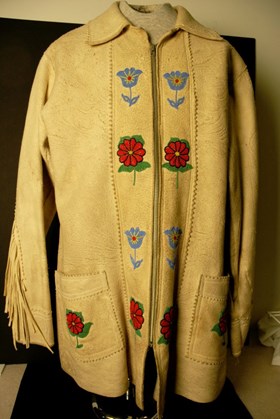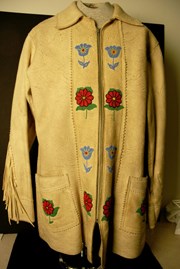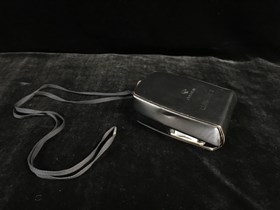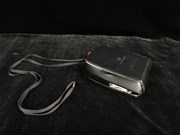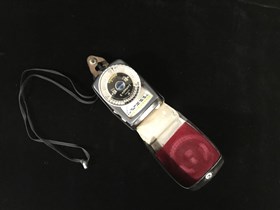Narrow Results By
- Date
- 1999
- Material
- skin, deer; glass; fibre;
- Catalogue Number
- 103.05.1186
- Description
- An untanned, buckskin jacket with floral beadwork design on the back across the shoulders in flowers with colours red, blue, black, yellow and leaves of green. The area below the beadwork is pinked and fringed. There is mirror image, identical beadwork on each side of the front of the jacket. There…
1 image
- Title
- Beaded Jacket
- Date
- 1999
- Material
- skin, deer; glass; fibre;
- Dimensions
- 50.0; with arms 167.5 x 88.5 cm
- Description
- An untanned, buckskin jacket with floral beadwork design on the back across the shoulders in flowers with colours red, blue, black, yellow and leaves of green. The area below the beadwork is pinked and fringed. There is mirror image, identical beadwork on each side of the front of the jacket. There is a zippered front closure and a pinked and beaded portion on each side of the zipper. The beadwork is alternating blue, yellow and red flowers with blue and yellow leaves and stems and then below flowers with colours of red, blue, black, yellow and leaves in green. There are four flowers on each side. On the flat front pockets the borders are pinked and the beadwork is a flower with red petals rimmed with black and a yellow centre. The leaves and stem are green.
- Credit
- Gift of Nicholas Morant, Banff, 2006
- Catalogue Number
- 103.05.1186
Images
This material is presented as originally created; it may contain outdated cultural descriptions and
potentially offensive content.
Read more.
Commemorative Medal
https://archives.whyte.org/en/permalink/artifact103.09.1247%20a-b
- Date
- 1992
- Material
- metal; fabric; cardboard
- Catalogue Number
- 103.09.1247 a-b
- Description
- Round silver medal and box. The medal commemorates 125 years since Confederation. (a) A round silver medal honouring the 125th Anniversary of the Confederation of Canada. The medal was struck by the Royal Canadian Mint. The medal honours Canadians who have made a significant contribution to their …
- Title
- Commemorative Medal
- Date
- 1992
- Material
- metal; fabric; cardboard
- Dimensions
- (a) 0.4; (b) 1.3; (c) 1.3 x (a) 3.5; (b) 5.0 ; (c) 4.7 x (a) 9.8; (b) 11.0; (c) 10.5 cm
- Description
- Round silver medal and box. The medal commemorates 125 years since Confederation. (a) A round silver medal honouring the 125th Anniversary of the Confederation of Canada. The medal was struck by the Royal Canadian Mint. The medal honours Canadians who have made a significant contribution to their fellow citizens, to their community, or to Canada. The medal is attached to a blue, white and red ribbon. At the top of the ribbon a pin has been attached so that the owner could wear it if desired. The case contains two holes for the pin to be clipped through, which would hold it in place. The Front of the medal contains the image of The Royal Cypher (EIIR) of the Queen of Canada, Elizabeth II, surmounted by a crown superimposed on a large single maple leaf, circumscribed with the legend “CONFEDERATION” and “CONFÉDÉRATION” and the dates “1867 — 1992” at the bottom.The Reverse Side contains The shield of arms of Canada encircled by the motto ribbon of the Order of Canada “DESIDERANTE MELIOREM PATRIAM,” which mean "They Desire a Better Country") ensigned by the central portion of the Royal Arms of Canada (a crowned lion holding a maple leaf in the right front paw) and circumscribed with the motto A MARI USQUE AD MARE at the bottom. The medal was only issued in 1992 and could not be awarded to a person who died prior to January 1, 1992. The Medal has no Bar or post-nominal. Nominations were made through the various branches of Government, as well as organization throughout the country.This Medal was awarded to approximately 42,000 Canadians.(b)The box is blue with both a top and bottom. The top of the lid has the crest of Canada in gold. Underneath the crest “CANADA” has been applied. Underneath the crest the dates “1867 – 1992” is indicated. When the lid has been removed one can see that the medal is resting on a cushioned support that has been retrofitted in the bottom of the box.
- Subject
- Nick Morant
- Credit
- Gift of Nicholas Morant, Banff, 2006
- Catalogue Number
- 103.09.1247 a-b
This material is presented as originally created; it may contain outdated cultural descriptions and
potentially offensive content.
Read more.
- Date
- 1933 – 1949
- Material
- plastic; paint; leather; metal; fabric
- Catalogue Number
- 104.41.1123 a-b
- Description
- (a)Gossen Lunasix exposure and colour meter in a pear shape with leather case. The light meter device measures the amount of light that is appropriate to achieve the proper exposure, indicating for the users which shutter speed and f-number should be selected. Along the top of the exposure meter in…
1 image
- Title
- Exposure Meter
- Date
- 1933 – 1949
- Material
- plastic; paint; leather; metal; fabric
- Dimensions
- (a)2.5; (b)04.5 x (a)6.5; (b)7.5 x (a)11.5; (b)12.0 cm
- Description
- (a)Gossen Lunasix exposure and colour meter in a pear shape with leather case. The light meter device measures the amount of light that is appropriate to achieve the proper exposure, indicating for the users which shutter speed and f-number should be selected. Along the top of the exposure meter in the viewer left corner is a white bulb-like part next to an open circular window that measures the amount of light present in the scene. When the converter slide, located along the viewer right side, is moved to the right and clicked into position the round window is open and ready to read the scene. At the top, on the face of the meter, the light measurement (scale) is present. This shows how much light is present in the scene and directly relates to the remaining scales on the meter. Below the light scale is a plexiglass film-speed setting disc with grooves that allow the operator to easily move the dial. In the middle of the dial there is the Lunasix manufacturer symbol. On viewer left side of this emblem is the DIN exposure index of the film in use; on the proper right side of this emblem is the ASA exposure index of the film in use. By moving the dial one adjusts the film-speed setting, which is indicated in the DIN and ASA boxes, whereby the index number is lined up against the triangular white marker in the respective window. A manual would have originally been sold with the object giving a more comprehensive overview of the film-speed table with a technical appendix. On the rear of the object in the viewer right corner one will see the correct position of the 2 batteries indicated through a tiny diagram. Below this is a metal battery chamber. Below this are the words “2 Batt. Mallory” “PX 625 o. PX 13”. To the viewer left of this writing is the ridged slide used for battery testing. Above the ridged slide are the words “Batt. Contr.” with a solid arrow below. Below the battery information is the table of footcandle (LUX) equivalents. In the middle of the table is the zero adjustable screw with an arrow pointing in both directions. AT the very bottom painted on the surface is the location of manufacturing; “GERMANY (WEST)” above a cutout window revealing the patent number; “4D01673”. (b) There is also a black leather case with the object. The inside of the case has gray suede lining, which would have helped avoid scratching and marking of the meter. The case has been carefully designed to retrofit the meter, which is apparent through the tiny leather strap present when the case is opened. These designs allow the object to be formly held into place further safeguarding it. At the bottom of the case there is a black button that allows the case to be opened and fastened shut. When the case is fastened shut, the name of the manufacturer “Gossen” appears imprinted and is upside down. Below this, also upside down, “LUNASIX 3” has been applied in silver ink. Along the viewer right side the case has a cutout that perfectly fit the converter slide. On the rear “MADE IN GERMANY” appears in a receded box with protruding lettering. The bottom of the case, where the button is located, contains an opening for the black string to be strung through. The string, which has been tied to the exposure meter, measures 49.0 cm and has a metal piece holding the ends of the string in place. This would have given the user greater security when working with the exposure meter.
- Subject
- photography
- Nick Morant
- Credit
- Gift of Nicholas Morant, Banff, 2006
- Catalogue Number
- 104.41.1123 a-b
Images
This material is presented as originally created; it may contain outdated cultural descriptions and
potentially offensive content.
Read more.
- Date
- 1933 – 1949
- Material
- plastic; metal; leather; paint; fabric
- Catalogue Number
- 104.41.1124 a-b
- Description
- (a)Gossen Lunasix exposure and colour meter in a pear shape with leather case. The light meter device measures the amount of light that is appropriate to achieve the proper exposure, indicating for the users which shutter speed and f-number should be selected. Along the top of the exposure meter in…
1 image
- Title
- Exposure Meter
- Date
- 1933 – 1949
- Material
- plastic; metal; leather; paint; fabric
- Dimensions
- (a)2.5; (b)04.5 x (a)6.5; (b)7.5 x (a)11.5; (b)12.0 cm
- Description
- (a)Gossen Lunasix exposure and colour meter in a pear shape with leather case. The light meter device measures the amount of light that is appropriate to achieve the proper exposure, indicating for the users which shutter speed and f-number should be selected. Along the top of the exposure meter in the viewer left corner is a white bulb-like part next to an open circular window that measures the amount of light present in the scene. When the converter slide, located along the viewer right side, is moved to the right and clicked into position the round window is open and ready to read the scene. At the top, on the face of the meter, the light measurement (scale) is present. This shows how much light is present in the scene and directly relates to the remaining scales on the meter. Below the light scale is a plexiglass film-speed setting disc with grooves that allow the operator to easily move the dial. In the middle of the dial there is the Lunasix manufacturer symbol. On viewer left side of this emblem is the DIN exposure index of the film in use; on the proper right side of this emblem is the ASA exposure index of the film in use. By moving the dial one adjusts the film-speed setting, which is indicated in the DIN and ASA boxes, whereby the index number is lined up against the triangular white marker in the respective window. A manual would have originally been sold with the object giving a more comprehensive overview of the film-speed table with a technical appendix. On the rear of the object in the viewer right corner one will see the correct position of the 2 batteries indicated through a tiny diagram. Below this is a metal battery chamber. Below this are the words “2 Batt. Mallory” “PX 625 o. PX 13”. To the viewer left of this writing is the ridged slide used for battery testing. Above the ridged slide are the words “Batt. Contr.” with a solid arrow below. Below the battery information is the table of footcandle (LUX) equivalents and is only for incident light. In the middle of the table is the zero adjustable screw with an arrow pointing in both directions. AT the very bottom painted on the surface is the location of manufacturing; “GERMANY (WEST)” above a cutout window revealing the patent number; “289337”. (b) There is also a black leather case with the object. The inside of the case has gray suede lining, which would have helped avoid scratching and marking of the meter. Some of this material must have worn away throughout the life of the case, as a red section of suede has been added to the case. The case has been carefully designed to retrofit the meter, which is apparent through the tiny leather strap present when the case is opened. These designs allow the object to be firmly held into place further safeguarding it. At the bottom of the case there is a black button that allows the case to be opened and fastened shut. When the case is fastened shut, the name of the manufacturer is protruding and reads: “GOSSEN”, which appears in the middle of a recessed circle. Below this, also upside down, “LUNASIX 3” is imprinted in protruding letters. Along the viewer right side the case has a cutout that perfectly fit the converter slide. On the rear “MADE IN GERMANY” appears in a receded box with protruding lettering. The bottom of the case, where the button is located, contains an opening for a black string to be strung through, which is also attached to the meter. The string, which has been tied to the bottom of the exposure meter, measures 49.0 cm and has a metal piece holding the ends of the string in place. This would have given the user greater security when working with the exposure meter.
- Subject
- Nick Morant
- Credit
- Gift of Nicholas Morant, Banff, 2006
- Catalogue Number
- 104.41.1124 a-b
Images
This material is presented as originally created; it may contain outdated cultural descriptions and
potentially offensive content.
Read more.

